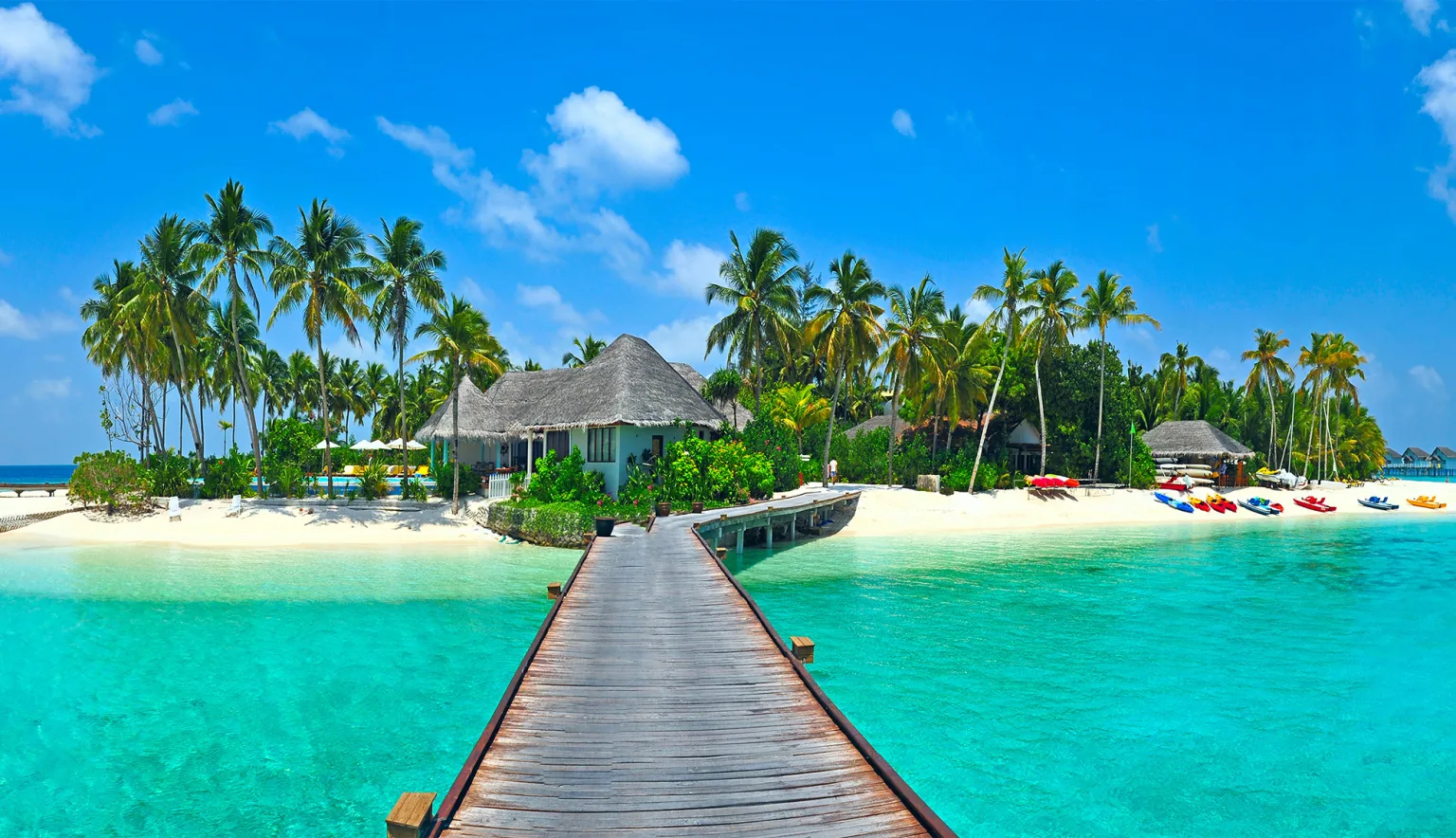The hallmark of luxury tourism, Maldives and its array of private resort islands continues to attract growing numbers of visitors looking for the perfect retreat.
MALDIVES
Maldives, commonly referred to as Maldive Islands and formally known as Republic of Maldives, is a fascinating stretch of landmasses in the northern Indian Ocean. The independent nation is made up of around 1,200 coral islands and sandbanks, of which 200 are inhabited, stretching more than 820 kilometres from north to south and 130 kilometres from east to west. This unique geography has resulted in a reputation for tourist luxury, with resorts often being housed on their own island and offering the perfect, all-inclusive private getaway.
Permanent inhabitants are almost all Maldivian, an ethnic group formed as a result of various groups of settlers arriving throughout the country’s history, the first being Tamil and Sinhalese peoples from Sri Lanka and Southern India. An important source of employment for locals derives from tourism, with visitors to the islands spoiled by the pristine beaches and opportunities to explore sea life and partake in water sports. The past decade has seen the industry open up, not least because inhabitants have been granted the power to build guesthouses on their islands, providing competition to resorts which have traditionally dominated the accommodation scene here.
THE BUSINESS END
Despite its reputation as a luxury travel destination, Maldives is one of the world’s economically poorest nations, its developing economy based around fishing and boat building. Tourism will be vital in the ongoing development of the nation. It is a fast-growing sector of the economy and is able to attract visitors all-year round, especially in hubs like Male which is home to an increasing number of modern hotels.
A look into February 2019’s statistics is cause for promise, with figures showing a 16.8 percent increase in visitor arrivals compared to the same month last year. In total, 168,583 visitors were recorded, China accounting for 17.8 percent of the total and European markets some 55 percent. As of February 2019, 137 resorts, 151 safari vessels, 12 hotels and 526 guesthouses of local islands were in operation, creating a capacity of 45,642 beds. Occupancy rate averaged 76 percent with an average stay of just over six days.
A key area of focus will now be on extracting more revenue per arrival. Despite an increase in visitor numbers, tax revenue from tourism goods and services actually fell slightly when compared to the beginning of 2018. However, the fact that 20 new resorts are due to open this year should help to bring in more income.
TOURISM INSIGHTS: VISIT MALDIVES
Visit Maldives (or Maldives Marketing & PR Corporation (MMPRC)) is mandated to promote all things tourism in the country, marketing the nation as a go-to destination for business travellers and holiday makers alike. A year on from last talking to the association, we caught up with Thoyyib Mohamed, the organisation’s current Managing Director, who fills us in on recent advancements made and advice for those paying the nation a visit.
Q&A WITH THOYYIB MOHAMED, MANAGING DIRECTOR, VISIT MALDIVES
What key progress have you made since we last featured Visit Maldives?
Thoyyib Mohamed (TM): Last year our main mission was to promote Maldives in different market segments. We have made successful campaigns and progress in this regard since we last appeared in Asia Outlook. By the end of March 2019, Maldives recorded 482,972 tourists from all over the world which is an increase of 15 percent compared to the same period last year.
How would you say the Maldives has developed in recent years as a business travel hub and what are the key reasons behind its growing appeal?
(TM): The resorts and hotels in Maldives are increasingly designed to cater for the business traveller. Hotels are equipped with the latest technologies to meet their needs. Important diplomatic and business meetings happen every day at these hotels in Male City. We believe the economic megaprojects of the country play a key role in opening Maldives as a hub for business. Maldives is a fast-developing country with great opportunities in the travel and hospitality industry, therefore, the developmental prospect combined with the amazing natural beauty attracts a lot of business travellers every year.
Why, in your opinion, should someone visit the Maldives?
(TM): Maldives is definitely unlike any other country. The beautiful geographic features, the unique culture and the warm nature of the people are some of the unmistakeable characteristics of our nation. Whether you are looking for a quiet peaceful moment in the sun or you want to stand on a roaring wave, Maldives will definitely meet your expectations.
Are there any specific attractions, landmarks or places to eat and drink that you would recommend?
(TM): Each and every atoll in the Maldives has a special and unique feature. It can be a place, tradition or even a food item. In the capital city you can enjoy almost every type of major cuisine from the world. There are unique underwater attractions such as spas, restaurants and rooms in the resorts. Since Maldives is 99 percent sea, the underwater beauty and dive points are also immensely popular among tourists.
What are the best ways of getting around the country?
(TM): We currently have three domestic airlines in the Maldives; the national airline Maldivian and private airlines Manta Airline and Flyme travel to all areas within Maldives. Maldives also have the biggest seaplane fleet in the world, which is operated by Trans Maldivian Airways. Other than air travel, there are convenient public ferry systems and public land transport networks.
What trends are transforming the tourism industry in the Maldives at present? How are you responding to these trends?
(TM): After the introduction of the guesthouses, it has quickly become one of the most popular products from Maldives. We are also working to market cultural and experience tourism. Our statistics show an increase in solo travellers and social media travellers, and we are currently focusing to cater to these demographics as well.
How do you see the Maldives developing as a business travel hub over the next year to two years?
(TM): As tourism is the largest contributor for the economy of our country, the government and the private investors have a mutual interest in the sustainability of the sector. Government is committed to expanding the international airport in order to increase arrivals. New resorts are developing, and many projects related to tourism are underway. Together with the Ministry of Tourism of the Maldives, MMPRC will embark on marketing campaigns and target new and emerging markets to increase exposure of the Maldives brand as a business and leisure destination.
Are there any plans or projects in the pipeline that you wish to highlight?
(TM): MMPRC is currently engaging in marketing campaigns on social media and other internet platforms. Recently we signed a contract with Singapore Airlines for a joint campaign to explore and implement activities to promote Maldives. These are just a few of the many activities we have already started this year. We are also partaking in the regular roadshows, FAM trips and international market fairs.
Are you optimistic about the future of the tourism industry in the Maldives?
(TM): Certainly, we see great potential for Maldives tourism to develop. Our marketing campaigns are not nearly as good as broad as some of our competitors’. Therefore, with the right approaches, we can certainly increase arrivals by a large amount.
MALE IN FOCUS
The Maldivian capital Male is fascinating in that it represents a stark contrast to the isolated tranquillity of the rest of the island nation. While the city is not awash with attractions, owing largely to its pintsized nature, it is the best place to meet locals and gain a flavour of Maldivian life. The fish market is thought as the sole of Male, a hive of activity and important source of produce for many of the city’s restaurants. That said, it does contain some of the country’s most important cultural and historical landmarks. For example, the Old Friday Mosque is UNESCO-protected and said to be one of the best structures made out of coral anywhere in the world.
The early 20th century Muleeaage, or Sultan’s Palace, is another landmark worth visiting and is next to the Medhu Ziyaarath, the tomb of Abul Barakat Yoosuf Al Barbary, known for bringing the Islamic faith to Male in 1153. More recent architecture can be found in the form of the China-Maldives Friendship Bridge, which connects the capital to nearby Hulhule. The project has been slightly controversial, with many locals claiming it will disrupt the ferry service across the lagoon.
OUTLOOK RECOMMENDS
STAY:
Featuring stunning over-water villas and private lagoons, The Residence Maldives is the ultimate place to base a relaxing holiday. Designed in harmony with the natural environment, the resort seamlessly blends traditional Maldivian architecture with contemporary elegance and modern comforts.
Based on one of the largest islands in North Male Atoll and surrounded by the Indian Ocean, One&Only Reethi Rah offers unrivalled privacy thanks to its all-villa setup. Guests enjoy luxury from the outset, including transfers which are arranged from Velana International Airport to the resort.
Situated in the Raa Atoll administrative division in the Maldives, Furaveri Island Resort & Spa occupies its own island and pairs luxury with a Maldivian twist. The resort is the perfect basecamp for holiday makers looking to explore the country’s natural wonders.
Scoring an average of 93 out of 100 across nearly 2,000 reviews, ROBINSON CLUB Maldives lies on an island with pristine beaches and within striking distance of beautiful coral reefs. The resort is billed as a perfect romantic getaway and is a popular wedding venue.
Just 25 minutes by speedboat from Velana International Airport, Baros Maldives has been welcoming guests to its island since 1973, making it one of the first resorts to open in Maldives. Baros prides itself on its provision of the highest standard of Maldivian hospitality.
Away from the bustle of Male, Taj Exotica Resort & Spa is spread across the Emboodhu Finolhu island (also known ad the Three Coconut Isle) in the middle of one of the largest lagoons in Maldives. Conveniently located just 15 minutes away from the airport by speedboat.
Fit with its own coral reef and shipwreck to explore, the Taj Coral Reef Resort & Spa is a diver’s paradise, complemented by exotic ocean views and sophisticated, streamlined accommodation. The resort has many accolades, including a TripAdvisor Certificate of Excellence.
DO:
EAT:
GETTING THERE AND AROUND
The island of Hulhule, two kilometres from Male, is home to Velana International Airport, transit hub for almost all flights in and out of Maldives. Two other international airports, Hanimaadhoo and Gan, also serve respective foreign markets in India and Sri Lanka. Domestic routes are served by national carrier Maldivian and FlyMe, while Mega Maldives Airlines flies into Beijing and Shanghai. Air is the most efficient way of getting between the islands, with 12 airports scattered around the archipelago. Remoter areas can be reached by seaplane, a great way to soak up views of the islands, reefs and lagoons, while boats are another common way of navigating Maldives.
On the islands themselves, bicycles are the best way to get from A to B. These are often supplied to guests free of charge, and mean that you can easily enjoy a holiday here without having to get into a car or hop on a bus. Male and Addu City are the only places where a bus service is necessary, the main purpose being to connect passengers to airports and seaplane terminals. Speedboat transfers are another option for those looking to get to and from these air transit hubs.























